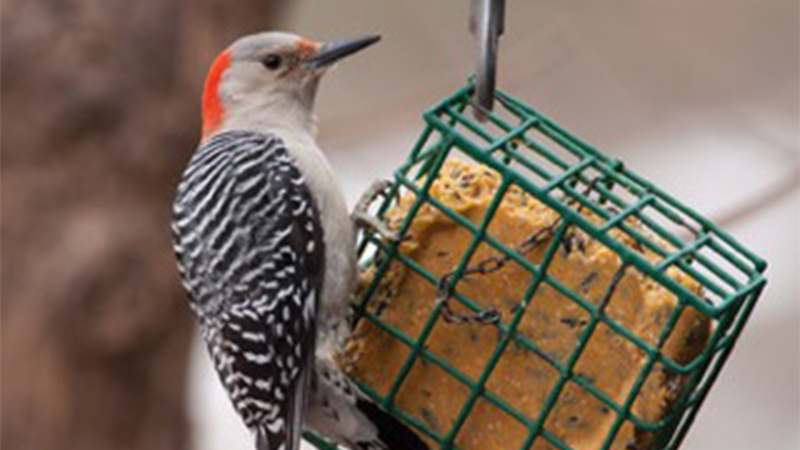Landrum Wanderings: It’s for the birds
Published 1:07 pm Monday, January 8, 2018

- Woodpecker at the suet feeder
I always credit my sixth grade teacher, Mrs. Rutherford, for developing my interest in birds. Our class joined the Junior Audubon Club and she had a bird chart on the wall. Every day we had to write on the chart what birds we saw as we walked to school. I learned to recognize and identify the local birds. Even today I can often recognize birds by their shapes, size, and beak.
I know the most common of bird calls like robins, jays, and chickadees. I’ve always kept a copy of “Peterson’s Field Guide to the Birds” along with a strong pair of binoculars close by. You never know when that unknown feathered friend will be warbling from a shady tree.
When the temperatures drop to freezing, I always fill the feeders morning and night. The birds need the food not only because they’re hungry, but because eating food is what keeps them warm. Chickadees need twenty times more food in the winter than they need in the summer. They feed all day in the cold temperatures so they can survive the nighttime temperature drops.
Trending
I want to learn more about winter feeding, so today I’m headed to Spartanburg. I know the folks at Wild Birds Unlimited will be able to give me the information that I need. It’s located at 468 E. Main and Denise and Eric Patten are the owners of this interesting store. Today I’m greeted by their son, Eric, who tells me with a smile that I came to the right person. He’s knowledgeable about birds and their feeding habits. “We take two exams a year that cover our products, what different birds need in their feed, and facts about birds.”
Even though it’s winter, and hummingbirds are vacationing in Mexico, he wants to let me know a basic misunderstood fact about feeding hummingbirds. “Do not put red coloring in the water,” he warns. “The red dye can actually cause kidney failure. Just use clear water in a container that has red color to attract them. Make a mixture of three or four parts water to one part sugar.” Checking online, it suggests boiling the water to dissolve the sugar and cooling before filling the feeder.
“Don’t forget that birds need water in the winter. Often their water source has frozen,” Eric reminds me. I ask if they sell a coil that can be plugged in to keep water in a birdbath melted. “Yes, we do,” he smiles. “But with the frigid temperatures lately, we’re sold out! We hope to get more in.”
We check out the suet section. “Birds need more fat in the winter than protein. Suet is a good way to provide that,” he explains. We have the typical square grid attached to one of our trees. Our house is surrounded by oak trees so the squirrels are plentiful. “We use the hot pepper suet to discourage the squirrels. Is that ok for the birds?” I inquire. Eric assures me that it is and shows me several “hot” products that they offer.
He describes the selection of various feeds, how they differ and what birds they attract. Cardinals like red berries. “Their color comes from the pigment in the red berries,” Eric informs me. “If they’re getting berries, it makes their color brighter and helps attract a mate in the spring.”
Every third Saturday of the month from 10 to 11 a.m. a class is held in the store. This month the focus is on ‘Twelve Elements To A Thoughtful Bird Feeding Station.’ Also, the shop will schedule talks for local garden clubs. I learn about their store club program that offers members discounts on products.
Trending
I make my purchases of special winter seed, dried meal worms for bluebirds, and hot pepper suet. I thank Eric for his assistance and head for home.
Back in Landrum, I check out the local sources for bird feeding products. Bi-Lo offers a wide variety of seed mix. The bags explain what’s in the mix and what birds the mix will attract. Because the bags are small, it would be easy to offer different mixes to discover what works best for your yard.
Ingles sells a variety of seeds plus large bags of safflower seed which many birds enjoy and it doesn’t interest the squirrels. They also have a wide selection of suet, plus ears of corn that can attract some critters. Offering corn for squirrels might deter them from visiting your feeders.
I discover many style bird feeders at Landrum Hardware along with large bags of seed to keep the feeders full. One attractive feeder is designed to keep the squirrels out. It resembles a bright red barn with feeding cavities along the base. When the squirrel steps on the bar that parallels the base, the bar goes down and covers the food troughs and the squirrel is out of luck!
I’ve learned other unusual bird facts along way. Did you know that chickadees have a language that utilizes the number of dee dee dees in their call? The call with the most ‘dees’ is a warning call. Even other birds and animals depend on chickadees to be the sentry that warns them of danger. During a class at FENCE, Simon Thompson mentioned that we are seeing birds winter over here that used to migrate since temperatures have been warming. This year they might have wished they’d gone to Florida!
The Wild Birds Unlimited calendar tells me that bluebirds can spot caterpillars and insects in tall grass at a distance of over 50 yards. Mated pairs of cardinals often sing duets together. The white crowned sparrow will average 70 miles a day when migrating north in spring.
I hope I’ve answered questions for you and given you some helpful tips. Happy Birding! For information on Wild Birds Unlimited: wbu.com/Spartanburg or 864-585-0409.





